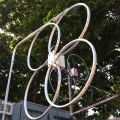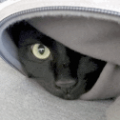The KiwiSDR 2 online store is open for orders! Please visit kiwisdr.nz
Please visit kiwisdr.com (documentation) and kiwisdr.nz (online store)
jks
About
- Username
- jks
- Joined
- Visits
- 30,988
- Last Active
- Roles
- Member, Administrator, Moderator
- Points
- 279
Reactions
-
v1.419,423: added non-NBFM squelch
Don't expect too much from this squelch implementation. It's not a VAD or anything. On the audio tab move the squelch slider fully left to disable (default). Two squelch values are stored separately: one for NBFM and another for all other modes (except DRM which doesn't need it).v1.419 November 8, 2020 Added a simple RSSI-based squelch for the non-NBFM modes. See audio tab of control panel. Based on Christoph's squelch from kiwirecorder.
For the non-NBFM squelch the slider represents dB above the median of a number of past RSSI (S-meter) values. There is also a menu of "tail" times -- additional time the squelch is held open before being closed.
The speaker icon now has a third color, white, indicating the squelch is closed (hence no audio). This in addition to red (muted) and green (squelch open or disabled). -
v1.419,423: added non-NBFM squelch
Don't expect too much from this squelch implementation. It's not a VAD or anything. On the audio tab move the squelch slider fully left to disable (default). Two squelch values are stored separately: one for NBFM and another for all other modes (except DRM which doesn't need it).v1.419 November 8, 2020 Added a simple RSSI-based squelch for the non-NBFM modes. See audio tab of control panel. Based on Christoph's squelch from kiwirecorder.
For the non-NBFM squelch the slider represents dB above the median of a number of past RSSI (S-meter) values. There is also a menu of "tail" times -- additional time the squelch is held open before being closed.
The speaker icon now has a third color, white, indicating the squelch is closed (hence no audio). This in addition to red (muted) and green (squelch open or disabled). -
v1.419,423: added non-NBFM squelch
Don't expect too much from this squelch implementation. It's not a VAD or anything. On the audio tab move the squelch slider fully left to disable (default). Two squelch values are stored separately: one for NBFM and another for all other modes (except DRM which doesn't need it).v1.419 November 8, 2020 Added a simple RSSI-based squelch for the non-NBFM modes. See audio tab of control panel. Based on Christoph's squelch from kiwirecorder.
For the non-NBFM squelch the slider represents dB above the median of a number of past RSSI (S-meter) values. There is also a menu of "tail" times -- additional time the squelch is held open before being closed.
The speaker icon now has a third color, white, indicating the squelch is closed (hence no audio). This in addition to red (muted) and green (squelch open or disabled). -
v1.419,423: added non-NBFM squelch
Don't expect too much from this squelch implementation. It's not a VAD or anything. On the audio tab move the squelch slider fully left to disable (default). Two squelch values are stored separately: one for NBFM and another for all other modes (except DRM which doesn't need it).v1.419 November 8, 2020 Added a simple RSSI-based squelch for the non-NBFM modes. See audio tab of control panel. Based on Christoph's squelch from kiwirecorder.
For the non-NBFM squelch the slider represents dB above the median of a number of past RSSI (S-meter) values. There is also a menu of "tail" times -- additional time the squelch is held open before being closed.
The speaker icon now has a third color, white, indicating the squelch is closed (hence no audio). This in addition to red (muted) and green (squelch open or disabled). -
v1.419,423: added non-NBFM squelch
Don't expect too much from this squelch implementation. It's not a VAD or anything. On the audio tab move the squelch slider fully left to disable (default). Two squelch values are stored separately: one for NBFM and another for all other modes (except DRM which doesn't need it).v1.419 November 8, 2020 Added a simple RSSI-based squelch for the non-NBFM modes. See audio tab of control panel. Based on Christoph's squelch from kiwirecorder.
For the non-NBFM squelch the slider represents dB above the median of a number of past RSSI (S-meter) values. There is also a menu of "tail" times -- additional time the squelch is held open before being closed.
The speaker icon now has a third color, white, indicating the squelch is closed (hence no audio). This in addition to red (muted) and green (squelch open or disabled).








